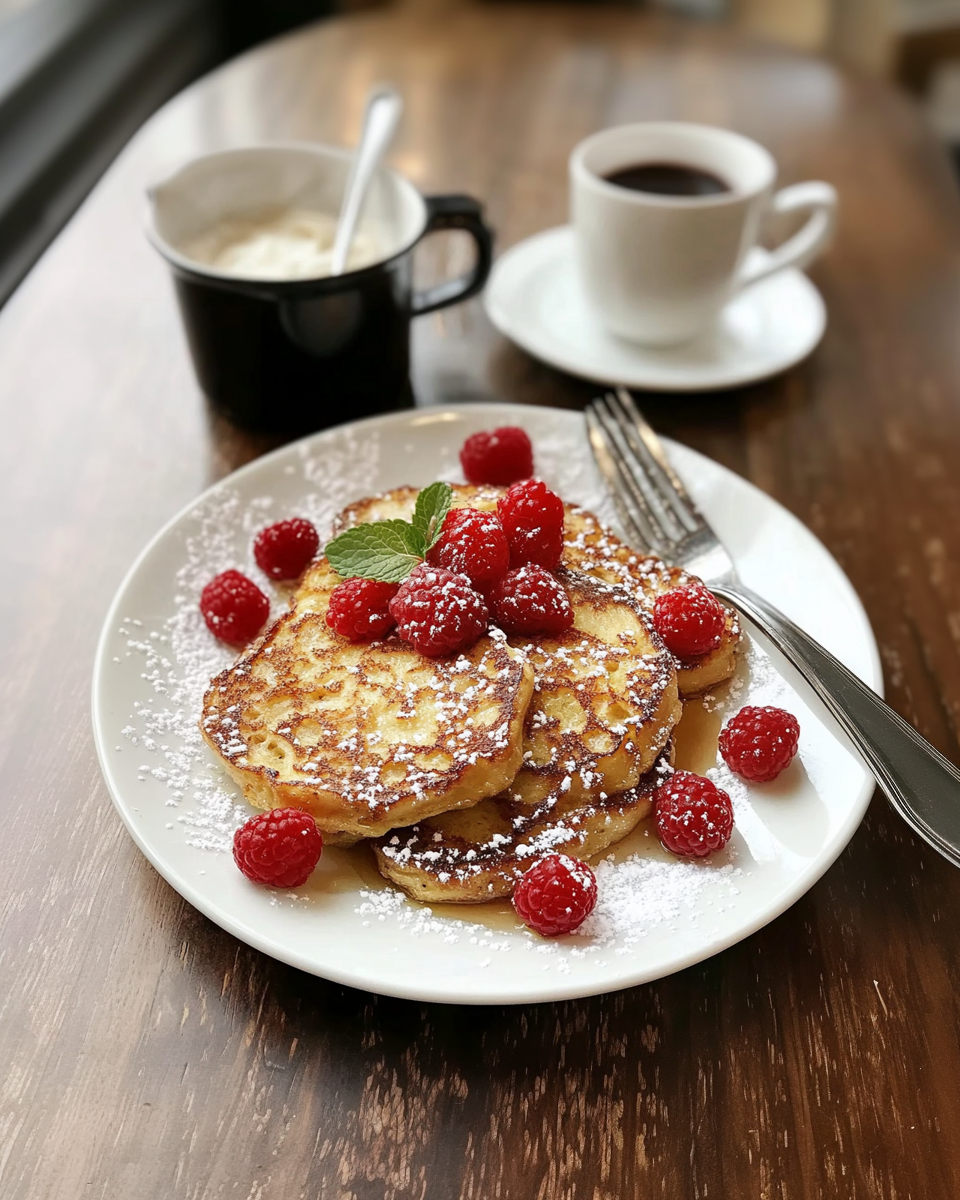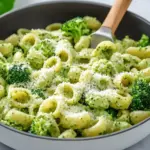This English Muffin French Toast recipe offers a delightful twist on a classic breakfast favorite. By utilizing the unique texture of English muffins, this dish achieves a crispy exterior with a soft, custardy interior. Perfect for a weekend brunch, it’s both easy to prepare and satisfyingly indulgent.
Full Recipe:
Ingredients
- Oil, for frying (vegetable, canola, or peanut oil)
- 1/4 cup milk
- 1/4 cup half-and-half or cream
- 2 large eggs
- 1 1/2 tablespoons granulated sugar
- 1 teaspoon vanilla extract
- 3 English muffins, halved
For serving (optional):
- Powdered sugar
- Fresh berries
- Maple syrup
Directions
- Preheat your oven to its warm setting (approximately 170–250°F or 75–120°C).
- In a shallow bowl or cake pan, whisk together the milk, half-and-half, eggs, sugar, and vanilla extract.
- Place the English muffin halves into the mixture, allowing them to soak thoroughly by flipping them several times.
- Pour about 1/4 inch of oil into a large nonstick skillet and heat over medium-high heat. Line a large plate with paper towels.
- Once the oil is hot, add the soaked muffin halves to the skillet. Cook on the first side for about 30 seconds, then flip and continue cooking until the muffins are golden brown. Adjust the heat as necessary to maintain the oil temperature without smoking.
- Remove the muffins from the skillet, gently shake off excess oil, and place them on the prepared plate. Pat with additional paper towels to remove any remaining oil.
- Transfer the cooked muffins to the warm oven to keep them hot while you cook the remaining batches.
- Serve warm, topped with powdered sugar, fresh berries, and maple syrup if desired.
Nutritional Facts (Per serving, assuming 1 English muffin half)
- Calories: Approximately 201 kcal
- Carbohydrates: 27.3 g
- Protein: 6.7 g
- Fat: 6.9 g
- Saturated Fat: 3.5 g
- Unsaturated Fat: 2.7 g
- Cholesterol: 60 mg
- Sodium: 313 mg
- Fiber: 1.6 g
- Sugar: 2.6 g
Why Choose English Muffins for French Toast?
The choice of English muffins instead of regular bread offers several advantages. English muffins have a dense yet spongy texture that absorbs the custard mixture beautifully without becoming overly soggy or falling apart. Their unique crumb structure holds the custard well, ensuring every bite is flavorful and moist inside while perfectly crisp on the outside.
This characteristic makes English muffin French toast ideal for those who love their French toast with a bit of crunch but still want that luscious creamy interior. The rough surface also caramelizes nicely when fried, lending a subtle, toasty flavor that complements the sweetness of the custard and toppings such as syrup, powdered sugar, or fresh fruit.
Culinary Flexibility and Serving Ideas
One of the biggest appeals of English muffin French toast is its versatility. It can be served simply with a dusting of powdered sugar or maple syrup for a classic breakfast. For a more indulgent treat, topping it with fresh berries, whipped cream, or even a drizzle of chocolate or caramel sauce can elevate the dish to a decadent brunch option.
Additionally, it pairs well with savory sides like bacon, sausage, or scrambled eggs, making it suitable for a hearty breakfast or even a brunch gathering. The smaller size of English muffin halves compared to traditional bread slices also makes it a perfect finger food for events or for kids who may prefer smaller portions.
Nutritional Benefits
While French toast is often considered a comfort food that may be rich in calories and fats, using English muffins can sometimes offer a slightly better nutritional profile. English muffins generally contain fewer calories than thick slices of bread, and their denser structure means less soaking of egg and milk mixture is needed to maintain firmness.
The recipe typically includes ingredients like eggs, milk or cream, and vanilla extract, which contribute protein, calcium, and flavor complexity. Eggs add a good amount of high-quality protein, vital for muscle repair and growth, while milk provides calcium essential for healthy bones. When combined with fresh fruit toppings, the dish also gains fiber, vitamins, and antioxidants, balancing indulgence with nutrition.
Tips for Perfecting English Muffin French Toast
To achieve the best results, a few key tips can elevate this recipe from good to exceptional. First, the soaking time matters: allowing the English muffins to soak long enough ensures the custard penetrates the bread thoroughly without becoming soggy. Too brief a soak may result in dry spots, while too long can cause mushiness.
Second, the cooking temperature is crucial. Medium-high heat is ideal for frying, as it creates a golden-brown crust without burning the exterior before the inside cooks through. Using a nonstick skillet and enough oil helps maintain an even fry and prevents sticking.
Third, keeping the cooked muffins warm in a low oven while frying subsequent batches ensures that all portions can be served hot and fresh. This step is especially helpful when serving multiple guests.
Historical and Cultural Context
French toast, known by many names worldwide — such as “pain perdu” in France or “eggy bread” in the UK — has been enjoyed for centuries as a resourceful way to use up stale bread. The English muffin French toast adaptation combines this tradition with a beloved British bread type, blending cultural influences in a simple yet elegant dish.
English muffins themselves have a rich history dating back to the 10th century, with modern versions popularized in the United States in the 19th century. By using English muffins in French toast, this recipe honors the bread’s heritage while embracing classic breakfast traditions.
Suitable Occasions and Pairings
English Muffin French Toast is a flexible dish that suits many occasions, from a cozy family breakfast to a festive holiday brunch. Its visually appealing golden crust and tender interior make it a crowd-pleaser.
For an easy weekend breakfast, it pairs perfectly with hot coffee or freshly squeezed orange juice. For more formal brunches or celebrations, you can present it on a platter garnished with fresh fruits, edible flowers, and small bowls of syrup and whipped cream.
Adapting the Recipe for Dietary Preferences
This recipe can be adapted easily for various dietary needs. For a dairy-free version, substitute the milk and cream with plant-based alternatives like almond, soy, or oat milk. Similarly, egg substitutes can be used to make it vegan-friendly, although this may affect the custard’s richness and texture slightly.
Whole wheat or multigrain English muffins can be chosen for added fiber and nutrients, and sugar can be reduced or replaced with natural sweeteners like honey or maple syrup.
Conclusion
English Muffin French Toast is a delightful and inventive take on a beloved classic breakfast dish. Its distinctive texture, appealing crunch, and custardy interior make it a standout choice for anyone looking to diversify their breakfast or brunch menu. Versatile, easy to prepare, and visually inviting, this dish can be adapted to various tastes and dietary needs.





